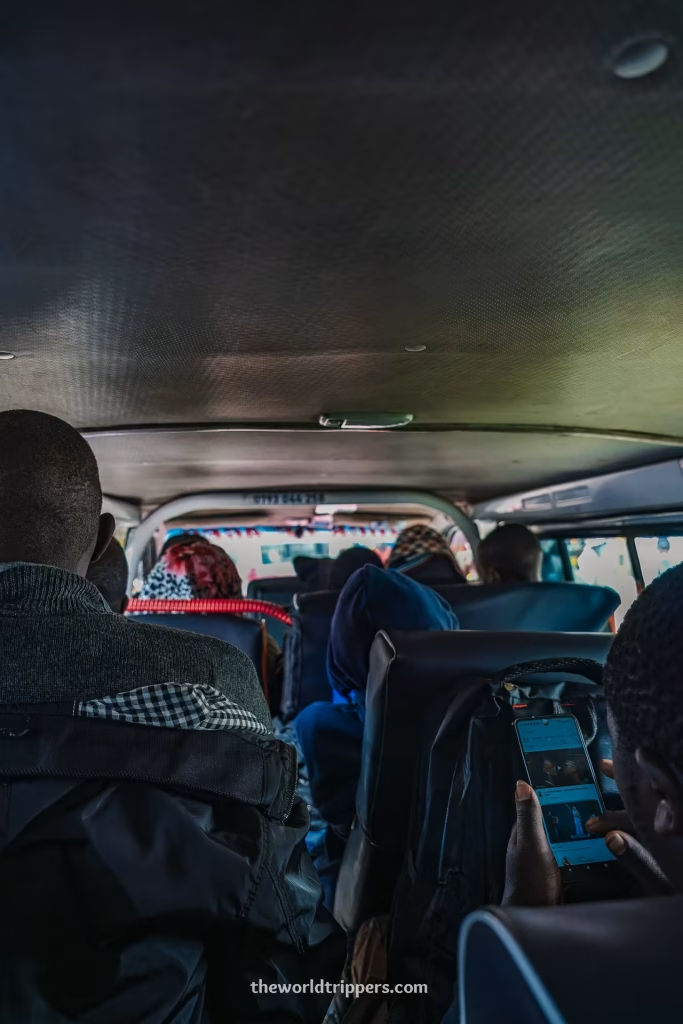Traveling by matatu in Kenya is a fantastic experience, but this mode of public transportation can also be a big challenge. Curled up in a small van with 15 other people, banging your head on the ceiling and with your backpack on your lap, you bump right through the Kenyan countryside and busy cities. On the left you see giraffes and on the right dozens of children stand waving at you. The matatu’s in Kenya are a surprise every day for which you must also have a good portion of patience. We spent 3.5 weeks traveling through Kenya by public transport and share all our tips below.
Content of this blog:
Matatu’s in Kenya: traveling in small vans
The main means of public transport in Kenya is the local minivan, called the matatu. The matatu has room for about 15 people but it is not full until literally no one else can get in. That means sometimes as many as 25 people are pushed in. There is also not always room to store your carry-on luggage, so you may have to keep it on your lap for hours.
Traveling by matatu in Kenya is certainly not always comfortable, but it is a tremendous experience. Locals always respond enthusiastically when they see tourists and all strike up a conversation. An additional advantage is that the locals all speak English extremely well. They are also extremely helpful in getting you to the right matatu and helping you out where needed.

Tips for traveling by matatu in Kenya
Be patient
The matatu does not leave at a specific time. Only when the minivan is full (i.e., really all the spots are occupied) does it start driving. This can mean that sometimes you have to wait a few hours. In Lake Naivasha, we arrived at the bus station at 07:30 at the matatu to Nairobi. We ended up not leaving until 10:30. Especially the fact that you have no idea when the matatu is going to leave is very annoying.
Don’t count on too many miles in a day
So because you sometimes have to wait up to 3 hours for the matatu to leave, you have to keep an ample schedule. You cannot make huge trips within Kenya in one day, simply because the rides take too long and the time spent waiting can add up considerably.
The longest drive we made was from Lake Naivasha (via Nairobi) to Amboseli, where we finally arrived just before sunset. Always count on it taking at least 1.5 times longer than it appears on Google Maps.


Always check with your accommodation on how to travel from place to place in Kenya
Often we had no idea how to get from one place to another by public transport in Kenya. We always asked this in advance at the accommodation.
Besides telling you exactly which route to take, they can also inform you about the price of the matatu. In fact, it still sometimes happens that, when they see a tourist, the price is doubled. This is not necessary the moment you know what a route should cost.
Average cost of a matatu in Kenya
In 2025, we traveled in Kenya for 3.5 weeks and spent the following for these routes:
- From Narok to Maasai Mara: 600 Kes ($5) per person.
- From Narok to Lake Naivasha: 800 Kes ($7) per person.
- From Lake Naivasha to Nairobi: 800 Kes per person.
- From Nairobi to Amboseli: 800 Kes per person.
- From Amboseli to Tsavo (Voi): 1100 Kes ($9) per person.
Keep in mind that sometimes you will be told a price that is way too high as a tourist. Therefore, we always recommend asking for the current prices from the host of your accommodation so that you know for sure what the local price should be. You can then also negotiate perfectly well.

Great coaches in Kenya with Easy Coach
Large coaches also operate between certain routes in Kenya. This travels a whole lot more pleasantly than by matatu in Kenya. You have these, for example, on the route from Nairobi to Narok (the base for Maasai Mara). This large coach is called Easy Coach. You can book tickets in advance through Easy Coach’s website. You can only checkout using Mpesa, the local online way of payment in Kenya. You can download Mpesa when you have purchased a local SIM card from Safaricom. You can read all about this in the blog: sim card in Kenya, safaricom and paying with Mpesa.
Train in Kenya
In addition to the matatu and coaches, a train track also runs through Kenya. The most famous route, and probably the only one you need as a tourist, is the train between Nairobi and Mombassa (Kenya’s coast).
From Nairobi you can travel by train to Voi, the base for the Tsavo National Park. After this, you travel on by train from Voi to Mombassa. Buy your tickets in advance through the Madaraka Express website. Also on this website you can only pay with Mpesa. Don’t have a Mpesa (yet)? Then ask your accommodation if they can reserve the tickets in advance for you so you can reimburse them.

Tips for the train in Kenya
- Always be at the train station at least an hour in advance. Checking in and routing at the train station is terribly cumbersome and if you are not on time, the train rides away. This one doesn’t wait a minute.
- Don’t bring sharp things in your suitcase. We had an expensive pocket knife in our backpack, which was taken out by security. This was not allowed on the train (unless we paid him 4000 Kes, then he did turn a blind eye….)
- You can choose first or second class when you book your ticket. First class is really a lot more relaxed, you sit on more comfortable seats and you have a lot more space. It is 3x as expensive as second class, where you sit mostly among the locals.
How does the train work in Kenya?
- So first of all, you buy a ticket for the train, first or second class, online through the Madaraka Express website.
- Then, on the day itself, arrive at the train station at least one hour in advance.
- Here you often have to first stand in a line where you show the tickets on your phone. Then you have to put down your luggage so a drug dog can sniff it. Then your luggage goes through a scanner.
- Then you have to physically pick up your train ticket at the office and this is the point where it takes a long time. You often stand in a huge line of people who just don’t seem to get on. You have to give your reservation number and your cell phone number to the cashier, who can then print your train ticket and hand it to you.
- After this, you and your luggage must once again go through security before arriving on the platform. Here you must walk to the right carriage and before boarding the train, you must once again show your train ticket to the conductor.
So traveling by train in Kenya can be very cumbersome and especially time-consuming. We almost missed the train once in Mombassa because the line for collecting train tickets was so long. Stressing early in the morning and having to run hard with a 15-kilo backpack on your back is not a very nice start to the day we can tell you.


Preparing for public transportation in Kenya
- Make sure you have plenty of cash on hand. You can almost always pay with cash Kenya Shilling only.
- Always bring plenty of water and food and drink. Public transportation in Kenya can be hot, crowded, busy and long.
- Always wear layers. It can get incredibly hot in the matatu and trains so make sure you can always take something off to cool off.
- Make it clear to the driver where you need to get out so they can stop in time for you.
Also enjoy Kenya’s public transportation and inefficiencies
As long as it takes and as frustrating as it can be at times, Kenya’s public transportation is an activity in itself. You see the craziest things, talk to nice people and feast your eyes. It is certainly not difficult to travel by public transport in Kenya and we didn’t feel unsafe either. As long as you always keep your belongings close to you and watch out with open windows and phones in crowded cities like Nairobi.
Driving a car yourself in Kenya
In addition to traveling by public transportation, you can also easily drive yourself by rental car in Kenya. In Nairobi it does get really crazy and we wouldn’t find it comfortable to drive, but beyond that it’s pretty doable. In Kenya they do drive on the left side of the road.
In addition, overtaking on the “highways” can also feel very exciting at first because some matatu or large trucks tend to push the small cars off the road. You get used to this fairly quickly and after 2 days you can judge the traffic a lot better. We recommend always renting a car with Sunnycars so you are all-in insured and have peace of mind. Also read our blog on renting a car in Kenya and driving it yourself.

